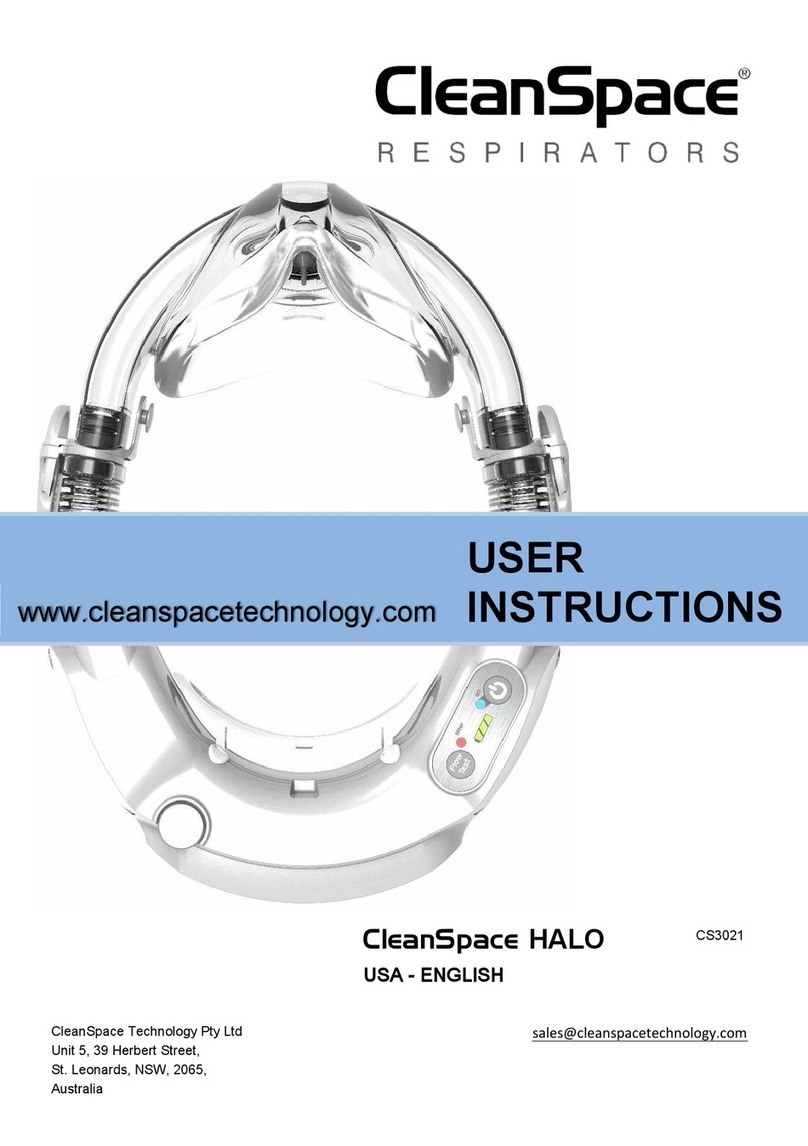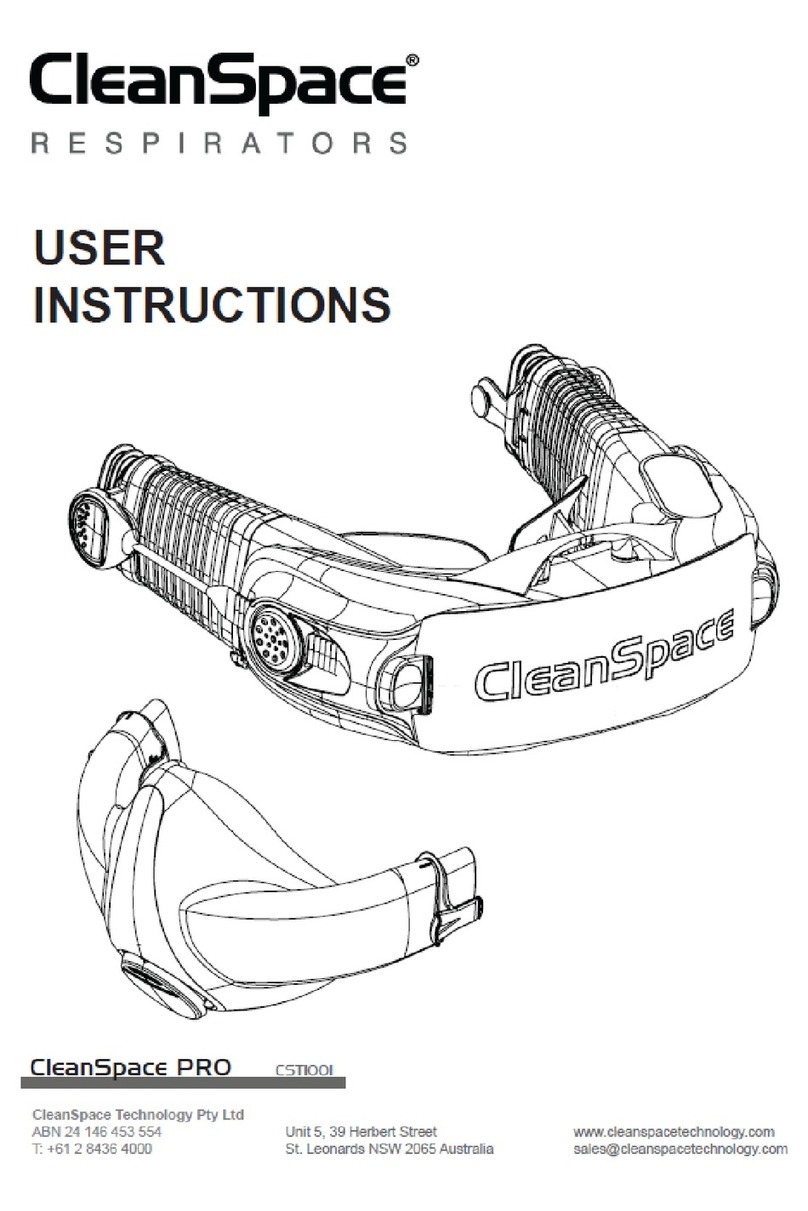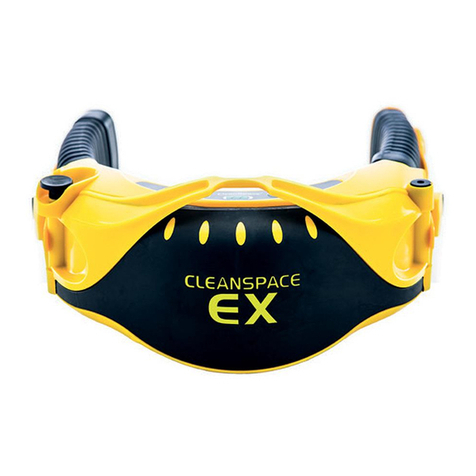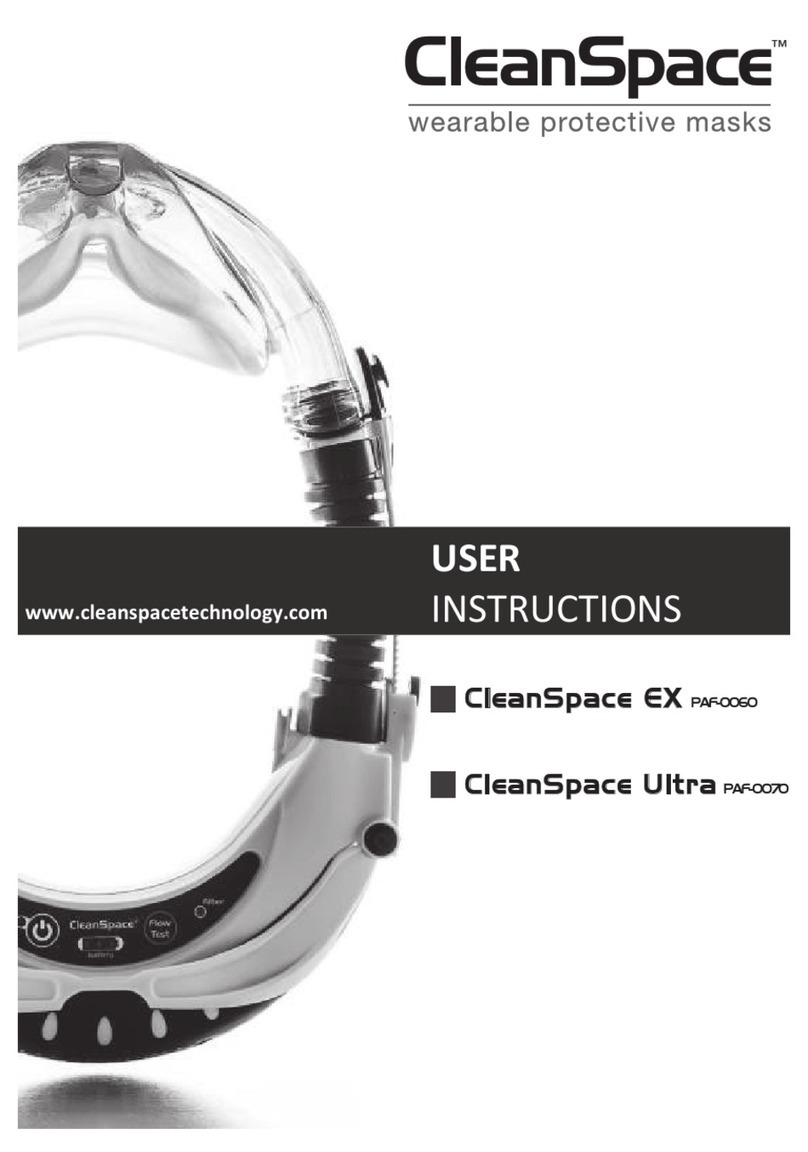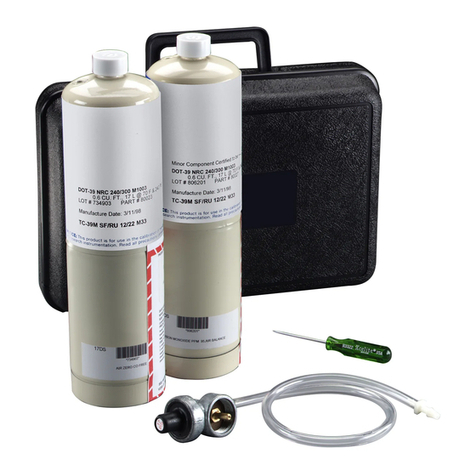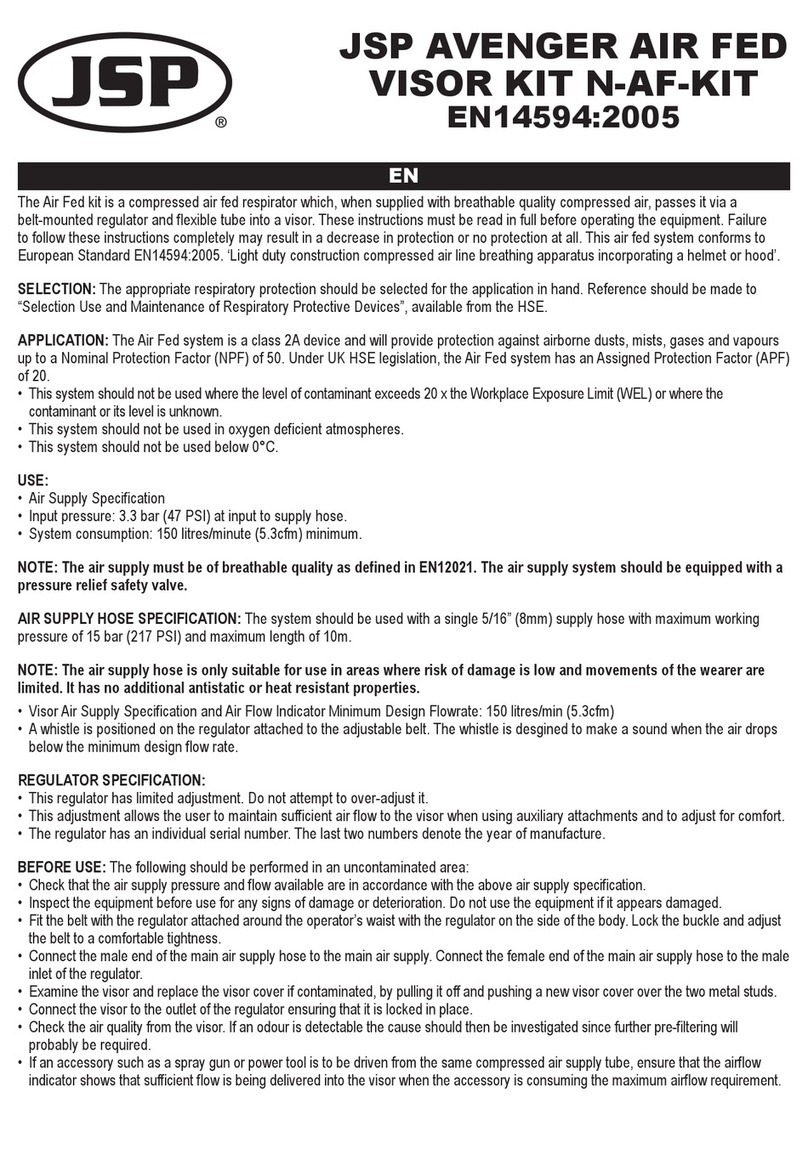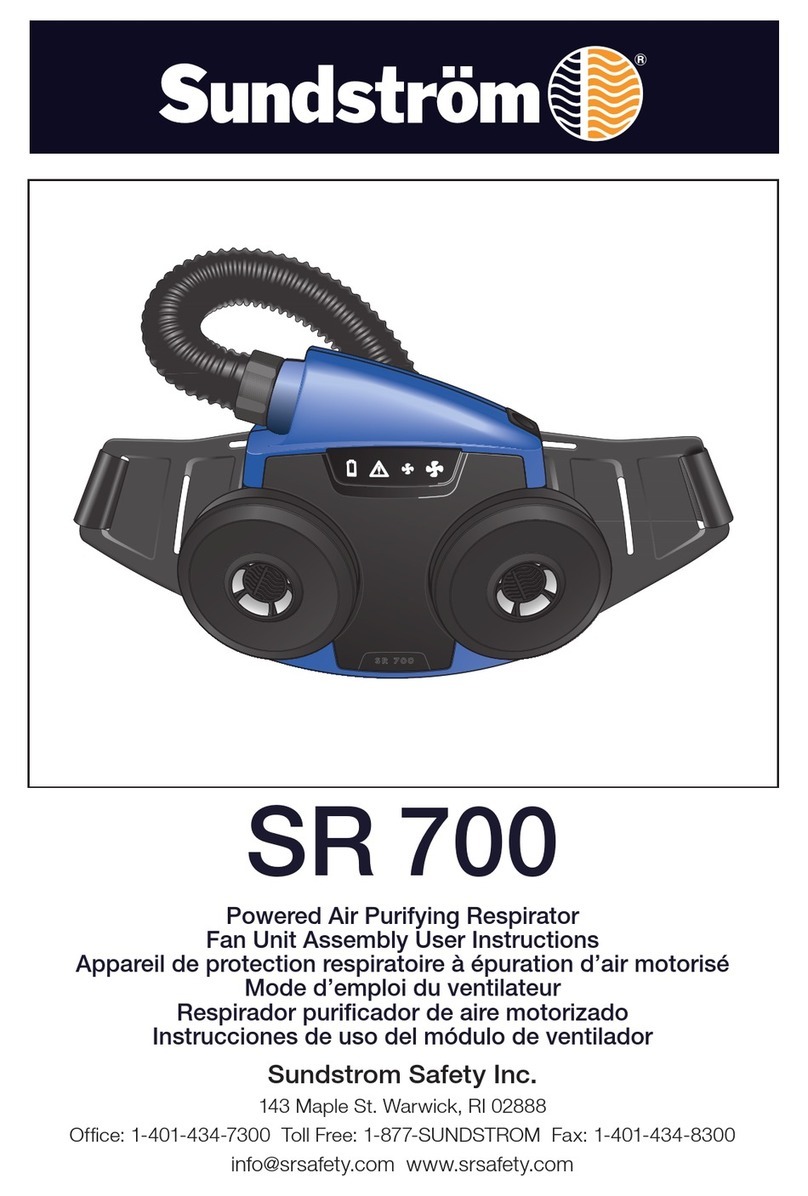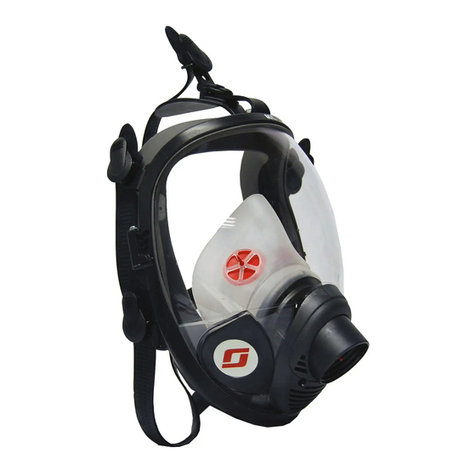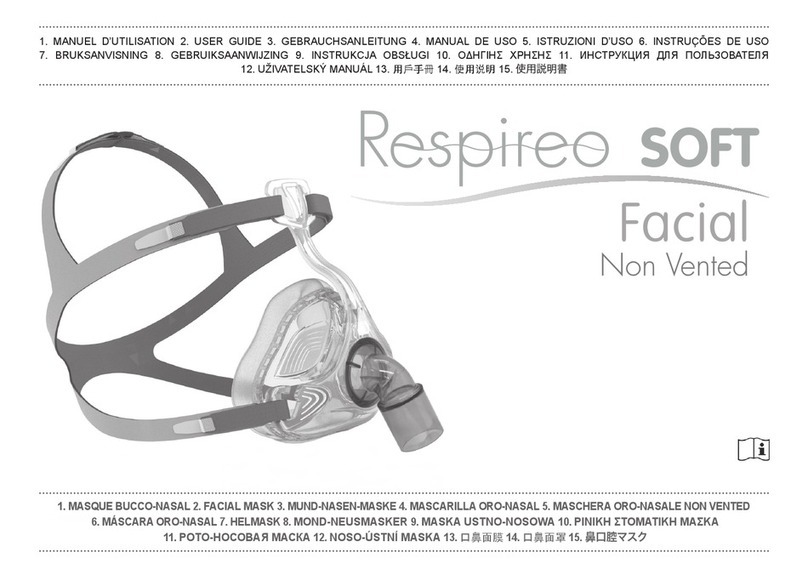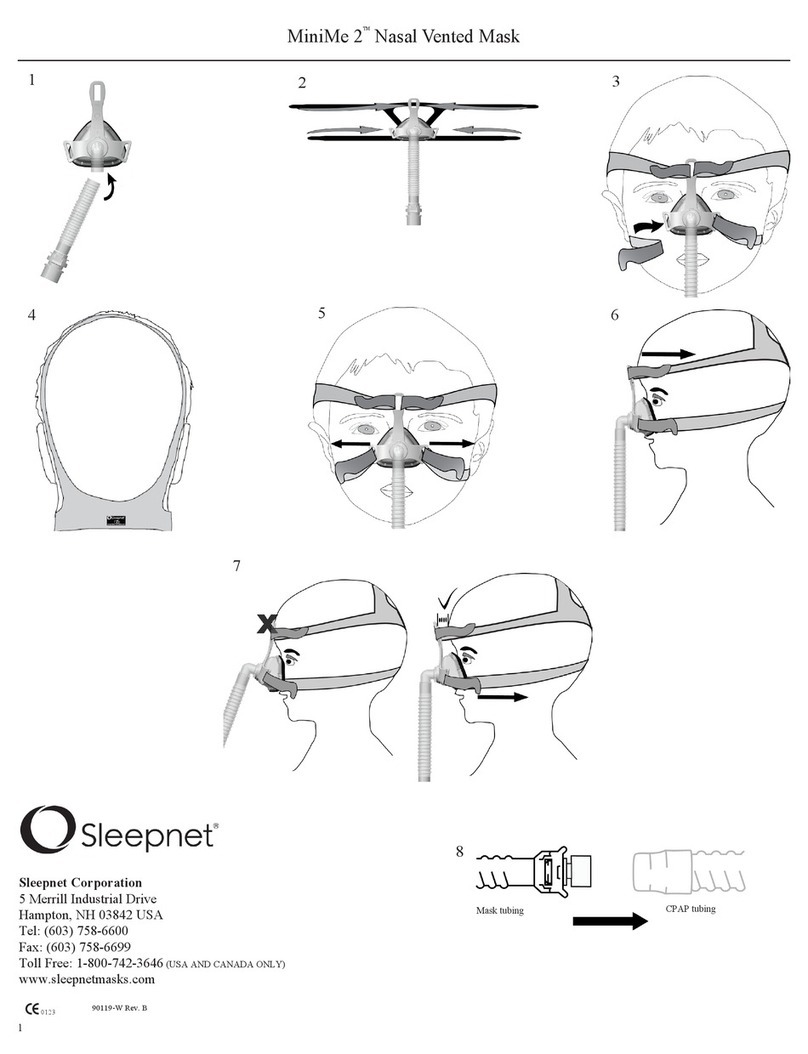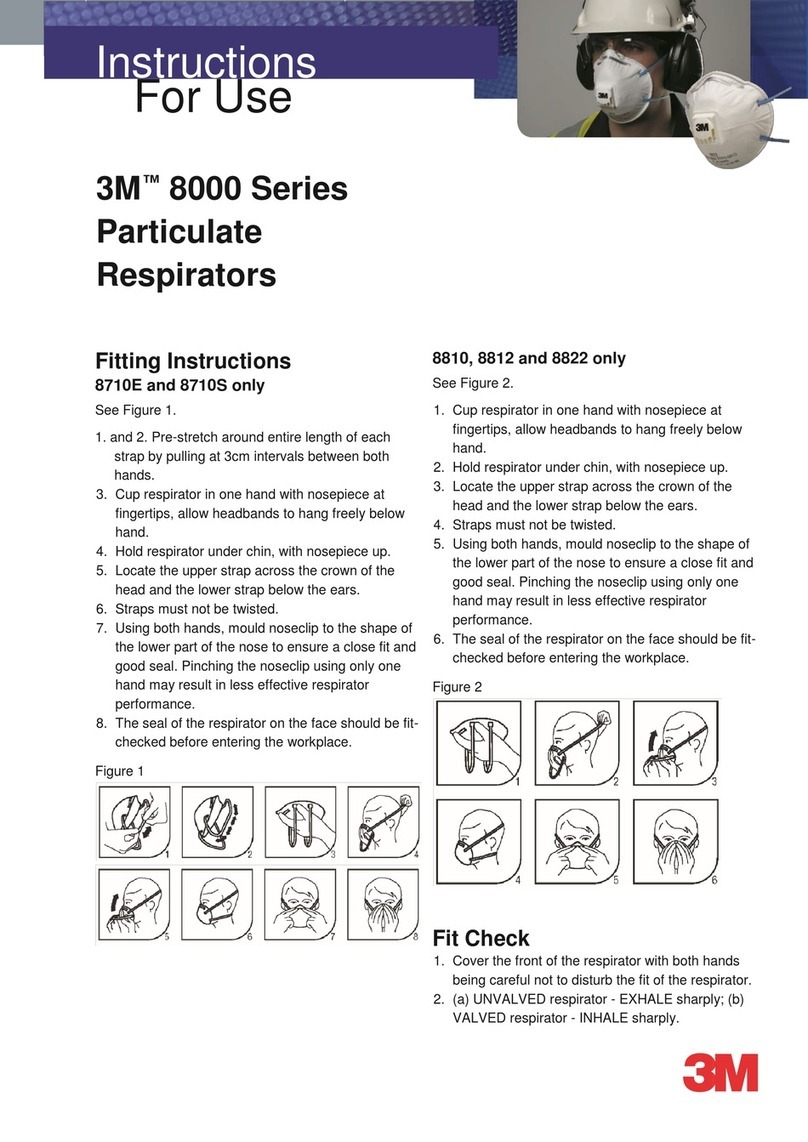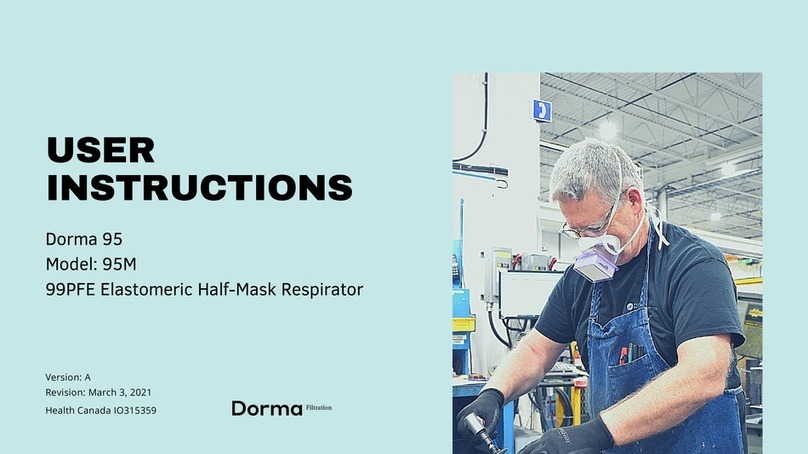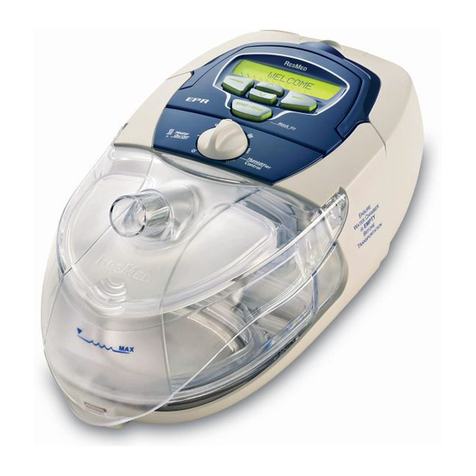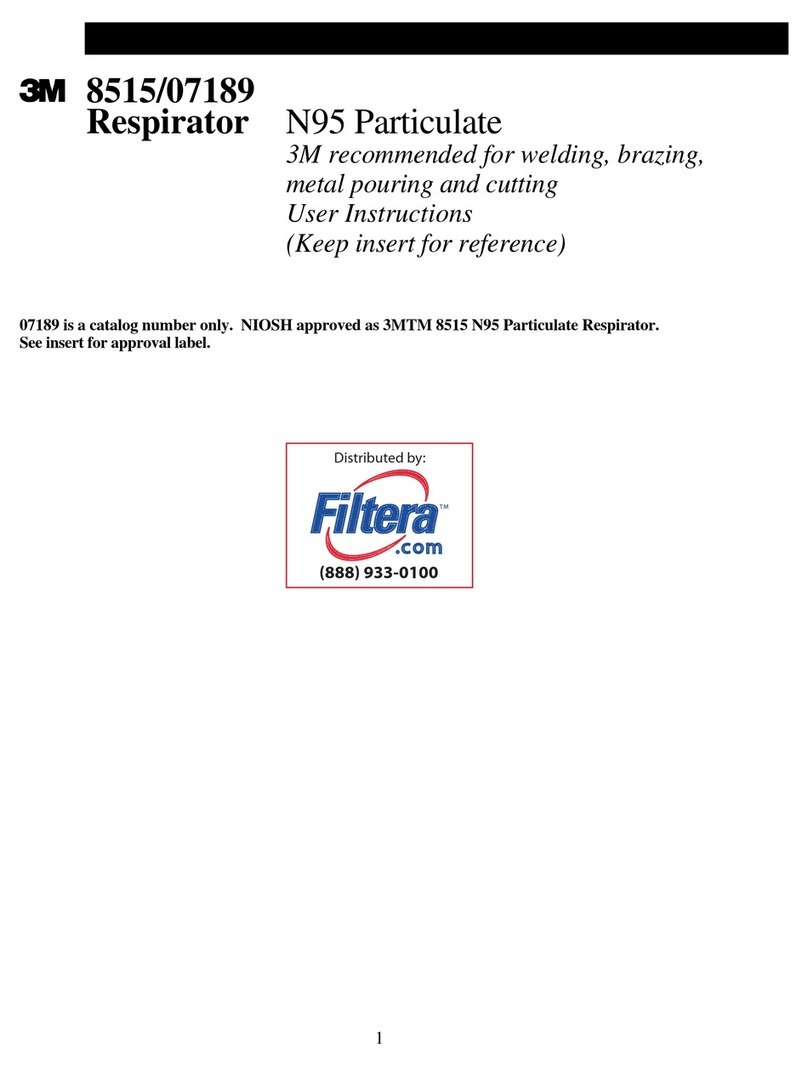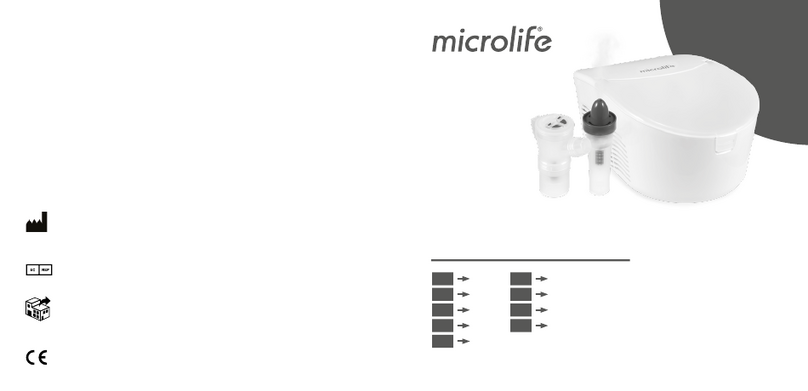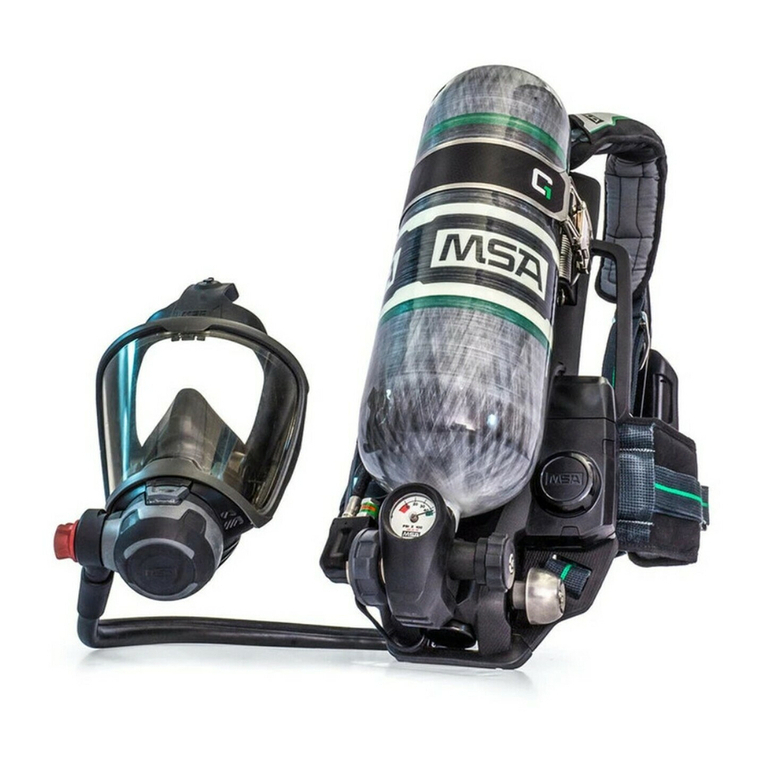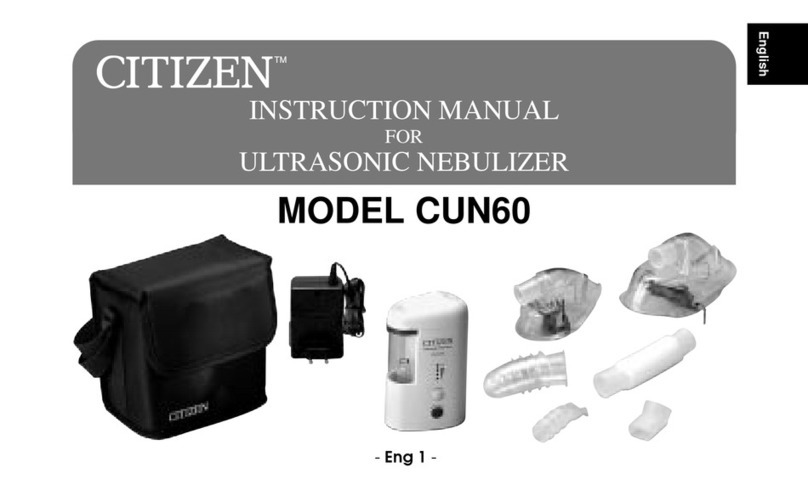CleanSpace HALO User manual

2
1. Contents
1. Contents............................................................................................................................................................... 2
2. Foreword.............................................................................................................................................................. 2
3. System Description.............................................................................................................................................. 3
4. List of Warnings within these User Instructions .................................................................................. 3
5. Special or Critical User Instructions..................................................................................................................... 4
6. Limitations of Use ................................................................................................................................................ 4
7. System Components............................................................................................................................................6
8. Controls and Indicators........................................................................................................................................7
9. Mask Fitting.......................................................................................................................................................... 8
10. Using CleanSpace HALO With Half Mask...........................................................................................................9
11. Using CleanSpace HALO With Full Face Mask................................................................................................17
12. Entering and Exiting the Contaminated Area.................................................................................................... 22
13. Working in Noisy Environments.........................................................................................................................23
14. Fitting & Changing the Filter ..............................................................................................................................23
15. Battery Information.............................................................................................................................................24
16. Cleaning.............................................................................................................................................................26
17. Periodic Maintenance & Checking.....................................................................................................................28
18. Approvals........................................................................................................................................................... 28
19. Specifications.....................................................................................................................................................28
20. Product and Accessory information...................................................................................................................29
21. Product Warranty...............................................................................................................................................29
Important: Before use, the wearer must read and understand these user instructions. Keep these user
instructions for reference.
Read these instructions in conjunction with the appropriate CleanSpace™filters and accessories instructions.
WARNING
This product is part of a system that helps protect against certain airborne contaminants. Misuse
may result in sickness or death. For proper use, see your Occupational Health Specialist, these
user instructions or contact CleanSpace Customer Service on 1 888 804 0038
2. Foreword
Read all instructions and warnings before using this device. Keep these user instructions for reference. If you have questions
regarding this system contact CleanSpace Customer Service sales@cleanspacetechnology.com or visit our
website: www.cleanspacehealth.com

3
3. System Description
The components of the CleanSpace HALO system are shown in Section 7. The respirator draws ambient air through
the high efficiency filter and supplies filtered air to the wearer via the mask. CleanSpace HALO is a breath
responsive respirator which means that it blows harder during inhalation and more softly during exhalation. The
device continuously adjusts fan speed to maintain positive pressure in the mask. Should the filter become blocked,
an audible alarm will sound and the “Filter” light on the keypad will be illuminated. If the battery voltage falls below
the minimum required to sustain the designed flow rate, an audible alarm will sound.
WARNING
Properly selected, used and maintained respirators help to protect against certain airborne
contaminants. It is essential to follow all instructions and government regulations on the use of this
product, including wearing the complete respirator system during all times of exposure, in order for
the product to help protect the wearer. Misuse of respirators may result in overexposure to
contaminants and lead to sickness or death. For proper use, see your Occupational Health
Specialist, these user instructions or contact CleanSpace Customer Service
sales@cleanspacetechnology.com or visit our website:www.cleanspacehealth.com
4. List of Warnings within these User Instructions
WARNING
This product is part of a system that helps protect against certain airborne contaminants. Misuse may result in sickness or death. For proper use, see your
Occupational Health Specialist, these user instructions or contact CleanSpace Customer Service on sales@cleanspacetechnology.com or visit our
website:www.cleanspacehealth.com
WARNING
Properly selected, used and maintained respirators help to protect against certain airborne contaminants by reducing concentrations in the wearer’s breathing
zone. It is essential to follow all instructions and government regulations on the use of this product, including wearing the complete respirator system during all
times of exposure, in order for the product to help protect the wearer. Misuse of respirators may result in overexposure to contaminants and lead to sickness
or death. For proper use, see your Occupational Health Specialist, these user instructions or contact CleanSpace Customer Service on
sales@cleanspacetechnology.com or visit our website:www.cleanspacehealth.com
CleanSpace HALO is a tight fitting respirator and National standards recommend the user be clean shaven.
IF A SATISFACTORY FIT FACTOR CANNOT BE ACHIEVED WITH ANY OF THE MASKS, CLEANSPACE HALO MUST NOT BE USED
DO NOT USE COMPRESSED AIR OR A BRUSH TO CLEAN THE FILTER!
FILTERS ARE DAMAGED BY THE USE OF COMPRESSED AIR OR BY BRUSHING.
Misuse of CleanSpace Respirators by cleaning the filter may result in overexposure to contaminants and lead to sickness or death.
IF A SATISFACTORY FIT CANNOT BE ACHIEVED, DO NOT ENTER THE CONTAMINATED ZONE
Be sure to remove the Seal Check Cap before entering the contaminated area. The Cap blocks the exhalation valve, making it more difficult for your
exhaled air to be expelled from the mask. Failure to remove the cap will lead to build-up of Carbon Dioxide in the mask, and may result in headache or
dizziness. Never leave the Cap in place for more than 2 minutes!
DO NOT REMOVE THE RESPIRATOR UNTIL YOU HAVE VACATED THE CONTAMINATED AREA unless you have immediate and sudden onset health
reasons to do so (for instance you are experiencing dizziness and believe removing the respirator while you leave the contaminated area may help)
IT IS ESSENTIAL THAT THE CORRECT FILTER TYPE IS SELECTED FOR THE CHOSEN APPLICATION.
If the blocked filter alarm is triggered (2 beeps, repeated every second, red LED flashes), leave the contaminated area immediately and replace the filter.
Operating the respirator after the blocked filter alarm has sounded can cause the flow to fall below the manufacturer’s minimum designed flow, which
may result in overexposure to contaminants and lead to sickness or death.
DO NOT USE WATER, COMPRESSED AIR OR ANY OTHER MECHANICAL METHOD TO CLEAN THE FILTER!
FILTERS ARE EASILY DAMAGED BY THE USE OF WATER, COMPRESSED AIR OR BY BRUSHING.
Misuse of CleanSpace Respirators by cleaning the filter may result in overexposure to contaminants and lead to sickness or death.
Use only NIOSH or CE Mark-approved CleanSpace™filters with the CleanSpace HALO™respirator. Certification or approvals are void if used with other
filters other than CleanSpace. Use of other filters may result in overexposure to contaminants and lead to sickness or death.
CleanSpace HALO is not intrinsically safe. Do not use in flammable or explosive atmospheres. Doing so may result in injury or death.

4
Always correctly use and maintain the internal lithium ion battery packs. Failure to do so may result in fire or explosion or could adversely affect
respirator performance and result in injury, sickness or death.
-Do not charge the internal battery with unapproved chargers or in enclosed cabinets without ventilation or near flammable liquids or gasses, or near
sources of high heat
- Do not immerse the device in water
- Do not use, charge or store the device outside the recommended temperature limits
If the battery alarm sounds (3 beeps, repeated every second), leave the contaminated area immediately and re-charge the battery.
Operating the respirator after the low battery alarm has sounded can cause the flow to fall below the manufacturer’s minimum designed flow, which
may result in overexposure to contaminants and lead to sickness or death.
The Flow Test is not a battery charge test. Three LEDs means that, as of the moment it is tested, the unit can deliver high flow. It does not mean the
battery is full. You must check the battery condition separately. See Section 16.
IN THE EXTREMELY RARE CIRCUMSTANCE THAT THE BATTERY IS DAMAGED AND ELECTROLYTE COMES IN CONTACT WITH EYES,
FLUSH WITH WATER IMMEDIATELY AND SEEK URGENT MEDICAL ATTENTION
WARNING: NEVER DRY THE MASK OR EXHALATION VALVE WITH A CLOTH THAT MAY LEAVE BEHIND LINT.
Lint contamination of the exhalation valve may cause it to leak, resulting in overexposure to contaminants and lead to sickness or death.
WARNING: The Respirator contains a battery, sensitive electronics and a motor. NEVER immerse it in water or use anything wetter than a damp cloth to
clean it.
WARNING: NEVER CLEAN THE FILTER WITH WATER, COMPRESSED AIR OR A BRUSH. FILTERS ARE DAMAGED BY THE USE OF WATER
COMPRESSED AIR OR BY BRUSHING.
Misuse of CleanSpace HALO by cleaning the filter may result in overexposure to contaminants and lead to sickness or death.
You must recalibrate the internal pressure sensor any time that your CleanSpace Respirator is exposed to changes in temperature of more than 20°C
5. Special or Critical User Instructions
This respirator contains a system for synchronising with your breathing and regulating mask pressure. This system
requires re-calibration whenever it experiences a change in temperature of more than 20°C. It is best
practice to also re-calibrate if the unit has been in storage, particularly if the storage temperature is not
known. For the most accurate battery charge indication, the respirator must be plugged into its charger. To be sure
it is fully charged, plug in the charger and wait for all 3 LEDs to light solidly without flashing. If the 3rd LED is
flashing rapidly, the battery is 95% charged.
6. Limitations of Use
Use this Respirator strictly in accordance with all instructions in these user instructions. Never modify or alter this
product.
•Do not remove the respirator until you have left the contaminated area, unless you have
immediately and sudden onset health reasons to do so (for example you are experiencing dizziness and believe
removing the respirator while you leave the contaminated area may help).
•CleanSpace HALO is a tight fitting respirator and National standards recommend the user be clean shaven. If a
satisfactory fit factor cannot be achieved with any of the masks, CleanSpace Respirators must not be used
•This Respirator WITH THE HALF MASK DOES NOT PROTECT YOUR EYES. In conditions that may damage
or irritate eyes, use protective eyewear.
•Only use your respirator with the parts and accessories listed on the Approval Label.
•Do not use the respirator unless it is powered and running normally.
•Do not use the respirator while it is being charged via the Battery Charger
•Do not use in airborne contaminant concentrations above those specified in your national regulations
•Do not use for respiratory protection against unknown atmospheric contaminants or when concentrations of
contaminants are unknown or immediately dangerous to life or health (IDLH).
•Do not use in oxygen deficient or oxygen enriched atmospheres. Do not use in flammable or explosive
environments.
•Only for use by trained personnel.

5
•Filters need to be changed regularly. The frequency of change depends on use and the concentration of
contaminants in the atmosphere.
•Do not use for escape purposes. National regulations may impose specific limitations on the use of filters
depending on the filter class and the facemask used.
LEAVE THE CONTAMINATED AREA IMMEDIATELY IF:
•Respirator warning lights and/or sounds activate for low battery or blocked filter
•Any part of the respirator is damaged
•Air flow into the mask decreases or stops
•Breathing becomes difficult or increased resistance occurs
•You feel dizzy or your airway is irritated
•You can taste or smell contaminants
CleanSpace respirators are suitable for use in the following atmospheric conditions:
•Operating Temperature Range: -10°C to 45°C
•Relative humidity: 0 to 90% non-condensing
The respirator will stop functioning if its internal temperature rises above 60°C or falls below -10°C
If the respirator has been used in an area that has caused it to become contaminated with a substance requiring
special decontamination procedures it should be placed in a suitable container and sealed until it can be
decontaminated.
Do not disassemble the respirator case. There are no user serviceable parts inside.
Failure to follow all instructions on the use of this product, and/or failure to use the respirator during times of
exposure, may lead to adverse effects on the wearer’s health and may render the warranty void.

6
7. System Components
Figure 1 - System Components

7
PARTS OF THE RESPIRATOR
Throughout this manual reference is made to various commonly-used components and features of the Respirator.
Familiarise yourself with these parts before reading the rest of the manual. See Figure 2.
Figure 2 - Parts of the Respirator
8. Controls and Indicators
POWER BUTTON
This button is used to switch between the three (3) operating Modes: “On”, “Standby” and “Off”
Mode.
i) Standby Mode is when the green battery indicator lights are on, the motor is not running and
there is no airflow to the mask. The respirator will automatically switch to Standby Mode within ten
(10) seconds of the user taking it off. If the respirator is in Off Mode it will switch to Standby Mode when the Power
button is pressed.
ii) On Mode is when the respirator is being worn, the motor is running and there is air flow to the mask. The motor
will start (called On Mode) when the respirator detects a change in pressure in the mask triggered by your breathing.
In On Mode you should hear the motor running and feel the airflow on your face. You can also switch to On Mode
(start the motor) from Standby Mode by pressing the Power button once.
iii) Off Mode is when the green battery indicator lights are off and the motor is not running and there is no air flow to
the mask. The respirator automatically switches into Off Mode three (3) minutes after it has been removed from the
user’s face and the sensors detect that there is no breathing.
To conserve battery life, the respirator is designed to automatically switch from On Mode to Standby then to Off
Mode when not being worn.
Important: In Standby Mode, the CleanSpace Respirator switches to On Mode as the wearer starts to breathe. The
respirator can only switch into On Mode from Standby Mode. If the respirator is in OFF mode, the motor will not run.

8
FLOW TEST BUTTON
This button is used to check that the respirator is able to deliver its minimum designed flow. Pressing it
once, when the CleanSpace is in Standby Mode (not ON Mode), starts the flow test which lasts about 5
seconds. See Section 10 for instructions on running the flow test.
BATTERY INDICATOR LIGHTS
Your respirator is equipped with an indicator of battery charge. There are three (3) battery indicator
lights. With the charger plugged in and three green lights lit, the battery is fully charged and typically has up to eight
(8) hours of operating time. The respirator should be fully charged before use.
If you need to be sure the battery is 100% charged plug in the charger. Even if the battery is fully charged, the 3rd
LED will flash for at least three minutes while the respirator checks its condition. Once all 3 LEDs light solidly
without flashing the battery is at 100%
For how to assess the level of charge, see Section 14.
When the battery approaches a level at which it would not be able to supply the Manufacturer’s Minimum Design
Flow, an alarm sounds (3 beeps, repeated once per second). All green battery lights are extinguished. If the low
battery alarm sounds you must leave the contaminated area immediately and recharge the battery.
Operating time is affected by mask seal, work rate and other factors. The operating times quoted above are
average durations at moderate work rates at sea level. Actual operating times may vary widely from average
durations.
FILTER WARNING ALARM
CleanSpace Respirators have a Filter Warning Alarm, which is triggered when the filter is blocked. If
the Filter Warning Alarm sounds (two beeps, repeated once per second) or the Filter Warning
Alarm light comes on, you must move out of the contaminated area, and change the filter.
9. Mask Fitting
Before using your respirator you must determine the right mask for your face and know how to adjust the system to
achieve a good fit.
It is vital that your mask is the right size for your face and fits properly. Mask fitting must be carried out by a
specialist / designated mask fitter.
To carry out a quantitative fit test your specialist mask fitter will require PAF-0025 PortaCount Adaptor and the
accompanying S005-7174 Quantitative Fit Test Instructions. The PortaCount Adaptor is an accessory that fits
between the mask and the exhalation valve and allows the air in the mask to be sampled. It comes with detailed
instructions on how to carry out a quantitative fit test.
CleanSpace HALO is a tight fitting respirator and National standards recommend the user be clean shaven.
IF A SATISFACTORY FIT FACTOR CANNOT BE ACHIEVED WITH ANY OF THE MASKS, CLEANSPACE HALO
MUST NOT BE USED
MASK SELECTION GUIDELINES
No set of guidelines can ensure that you have the right size mask for your face. You must confirm the fit
with a quantitative fit test. But the table below will help your mask fitting specialist to select the mask most likely to
fit you, and may therefore save time.

9
Once you have achieved an acceptable mask fit and confirmed it with a quantitative fit test, record your information
in the table below.
Name
Mask Size
Neck Support
Fitted / Not Fitted (Circle one)
Date of Quantitative Fit Test
Fit Factor on Test
IF A SATISFACTORY FIT FACTOR CANNOT BE ACHIEVED WITH ANY OF THE MASKS,
CLEANSPACE RESPIRATORS MUST NOT BE USED
10. Using CleanSpace HALO With Half Mask
Complete the following five steps each time you use your respirator.
STEP 1 - INSPECT
Before each entry into a contaminated area, the following inspections must be performed:
▪Visually check the all parts including the Respirator, mask, harness and filter. If parts are missing or damaged
replace only with approved parts before proceeding.
▪Check the RESPIRATOR for cracks, holes or other damage or missing parts. Do not use the device if there is
any damage or misuse. Check both bellows for splits or holes. Check that the bellows have not become
distorted so as to partially or fully close the air path to the mask. Check and fit the neck support (if required).
Check the battery is fully charged by pressing the Power button. All three (3) battery Green LEDs must light
up. See Section 14.

10
▪Check the FILTER carefully. The foam seal must be clean and free from damage of any kind. Examine the
visible internal surfaces for any sign that dust has penetrated the media. If dust is found, do not use the filter.
The body of the filter must be free of cracks or signs of damage. If any sign of impact or scratching is found,
discard the filter. Fit the filter to the Respirator (see Changing the Filter, below)
DO NOT USE COMPRESSED AIR OR A BRUSH TO CLEAN THE FILTER!
FILTERS ARE DAMAGED BY THE USE OF COMPRESSED AIR OR BY BRUSHING.
Misuse of CleanSpace Respirator by cleaning the filter may result in overexposure to
contaminants and lead to sickness or death.
▪Check the MASK to ensure that there are no cracks, tears or dirt; check the mask is not distorted. Check the
mask exhalation valve for damage or dirt build up. If it is dirty, remove the exhalation valve cover. Remove any
dirt, hairs or anything that could affect the seal of the valve against its seat. Check that the valve seat is clean.
Reinstall the valve cover. If the valve is damaged, replace the mask.
▪Check the HEAD HARNESS is intact and has good elasticity and can be fitted to the attachments on the
mask. It must be adjusted to support the mask to seal comfortably to the face. DO NOT overtighten.
STEP 2 –CALIBRATE
This respirator contains a system for synchronising with your breathing and regulating mask pressure. The system
should be re-calibrated if it experiences a significant change in temperature of more than 20°C. It is best
practice to re-calibrate if the unit has been in storage when the storage temperature is unknown.
Steps to re-calibrate:
1. Remove the filter from the respirator.
2. With CleanSpace Respirator in Standby Mode (ie one or more green LEDs lit), press the “Power” and “Test
Flow” buttons on the keypad at the same time.
3. The red and blue LEDs will both light, and the green battery LEDs will cycle.
4. Hold the respirator still until the red and blue LEDs turn off (10 –15 seconds). After this, calibration is complete.
5. At the end of the calibration process the green LEDs return to indicating battery charge status.
STEP 3 –TEST FLOW RATE
This test checks that the Respirator is able to deliver the Manufacturer’s Minimum Design Flow of 120 litres/minute.
1. Remove the mask from the respirator. Place the respirator flat on a table or other support.
2. Press and release the button marked “Flow Test”
3. The respirator will automatically run the Flow Test. Note: During the test, the motor will run fast and air will
blow from the left hand bellows.
4. After 2 seconds the respirator reports the Test result using the LEDs on the keypad. Use the table below to
interpret the LEDs.
LIGHTS
Meaning
3 LEDs:
PASS (Excellent: flow >180 l/min)**
2 LEDs:
PASS (Good)**
1 LED:
PASS (Acceptable)
ALL LEDs
FLASH
FAIL (Flow <120 l/min)
Do not use the respirator until a new filter has been fitted and / or battery fully charged and the test has
been repeated with a PASS result. Reset the respirator by pressing the Power button. Fully charge the
battery and / or replace the filter. Repeat the flow test. If the respirator fails the test filter is new and battery fully
charged but, contact CleanSpace Technology and do not use until it has been evaluated
** WARNING: The Test Flow Rate is not a battery charge test. Three LEDs means that, as of the moment it is tested, the unit
can deliver high flow. It does not mean the battery is full. You must check the battery charge separately. See Section 16.
STEP 4 - DON THE RESPIRATOR
NOTE –please read STEP 4 all the way through before beginning to don the respirator
Locate your respirator, mask, neck support and harness. Make sure the mask is the size that you used for your
last successful quantitative fit test. This size should be recorded in this manual (see Section 9). ENSURE A
CLEAN FILTER IS FITTED TO THE POWER UNIT.

11
•Fit a CleanSpace mask to the respirator
With the peak of the mask upright locate the right hand mask AirClip. Locate the right hand respirator AirClip. It
is on the same side of the respirator as the Keypad.
Figure 3 - Right hand mask AirClip
Figure 4 - Right hand respirator AirClip
ENSURE A CLEAN FILTER IS
FITTED TO THE POWER UNIT.
(See Section 13)

12
Check that the mask is the right way up! The pointed nose section of the mask must face up, in the same
direction as the keypad. See Figure 6.
Figure 6 - Nose section of mask and keypad must both face up
Leave the other mask arm and bellow free until you are fitting the Respirator.
Familiarise yourself with the Adjust Buttons and the Mask Release Buttons. See Figure 7
Figure 7 - Mask Release Button and Adjust Button
Figure 5 - Mask on Blower (Note - connection is on right
hand side)
Join the AirClips, so that the mask is attached to the respirator.
See Figure 5.

13
•Fit the Harness
Holding the harness find the two keyhole clips at the end of each elastic strap. And the marker, indicating
the front of the harness. Fit the harness clips to the buttons on the inside of each Mask Airclip. Ensure that
the harness strap with the FRONT marker is towards the front of the mask and that there are no twists in
the straps. See Figure 8. And Figure 9.
Figure 8 - Harness Fitting The two straps of the harness fit to the inside of the AirClips on the mask.
Figure 9 –Adjust Harness length By moving cleats up or down strap. ENSURE THE MARKER IS
LOCATED AT THE FRONT OF THE HEAD HARNESS.
FRONT MARKER

14
•Fit a Neck Support
Align the neck support with the respirator, the two arms with the rounded heads should be at the top. Locate
the bottom arms of the neck support in the grooves at the bottom of the unit and slide neck support upwards
until you hear a ‘click’.
Figure 10 - Fitting neck support
•Loosen both bellows to their widest opening
Press the adjust button on the respirator and loosen the bellows on both sides so they are fully extended.
See Figure 11.
Figure 11 - Adjust Button
•Place the Respirator in Standby Mode
Press the Power button once. The Green Battery LED lights will light up on the respirator. The motor will not
come on and the air will not flow in Standby Mode.
•Don the Respirator and switch to On Mode
Place the respirator behind your neck with the bellows and mask resting down one side,. The harness should
be hanging in front of mask (Figure 12 –14). Fasten the AirClips on your left-hand side so both sides of the
mask are connected to the Respirator. Pull the mask up to sit comfortably on your face (Figure 15). Start to
breathe to trigger the system into On Mode for the air to flow. Pull the harness back and onto your head
(Figure 16). Adjust harness and settle the mask and power unit so both are comfortable. Adjust the bellows
and harness to achieve a comfortable fit and seal on the face. DO NOT OVER TIGHTEN THE SYSTEM
(Figure 17)
Power button on keypad

15
ON MODE: From Standby Mode, when the mask is placed on the face, the wearers breathing will trigger the system
to start (On Mode) and the air to flow. Breathe normally. The wearer should feel fresh air on the face and the motor
adjusting to the breathing patterns.
If the motor does not start and air does not flow, check the system was in Standby Mode (with the Battery green
LEDS on). If the system is Off, (ie not in Standby Mode and no green LEDS), remove the respirator, press the
Power button to activate Standby Mode and don again as described Figures 12 –17 above.
•Check the Harness
The Harness should take a little of the weight of the mask and support the respirator so that the respirator system
sits level on your head. If necessary adjust the harness. This is done by shortening or lengthening the front straps of
the harness, by moving the cleats up or down the straps. Remember to shorten or lengthen each side by the same
amount.
Figure 15 –Pull mask up and
onto face
Figure 16 –Pull harness back
and onto head
Figure 17 - Settle harness and
adjust
Figure 14 –Device fastened
around neck
Figure 12 - Blower behind
neck
Figure 13 –Fasten
AirClip

16
Figure 18 - Correct Position for CleanSpace HALO
•Adjusting the mask on your face
Adjust the mask for comfort and until you feel
no leaks between the mask cushion and your
face.
To tighten the system, place one hand against
the back of the respirator and the other over
the front of the mask. Squeeze the respirator
forwards and the mask back, You will hear a
series of clicks as the mask is tightened.
To Loosen the system, press the adjust buttons
on either side of the bellows, and pull the mask
and respirator away from each other.
STEP 5 –CHECK MASK SEAL
It is recommended to do a fit check every time you wear a CleanSpace Respirator. To conduct a check on the
mask seal, use PAF-1009, the red Seal Check Cap, and fit the Cap over the exhalation valve in the mask. The Cap
will snap into place. See Figure 20. After the cap is fitted and you have checked no air is flowing from the
exhalation valve, don the mask and breathe normally. Using your fingers, feel around the edge of the mask for
leaks which can be felt as a cool air flow over your finger. Wetting your fingers makes it easier to feel leaks. For
greater sensitivity breathe out firmly to raise the mask pressure. It is recommended that during the Seal Check you
move your head by tilting the head up and down and side to side. Adjust the system if leaks are detected. Once you
can feel no leaks from the mask, the seal check is complete. While conducting the Mask Seal Check, never leave
the cap in place for more than 2 minutes while the respirator is donned.
Figure 20 - Fitting Seal Check Cap
IF A SATISFACTORY FIT CANNOT BE ACHIEVED, DO NOT ENTER THE CONTAMINATED ZONE
Figure 19 –Adjusting the Mask

17
Before entering the contaminated areas, remove the Seal Check Cap by gently twisting the handle so that one side
of the cap comes loose from the exhalation valve. Be careful not to dislodge the exhalation valve cover. See
Figure 21.
Figure 21 - Removing Seal Check Cap
Be sure to remove the Seal Check Cap before entering the contaminated area. The Cap blocks
the exhalation valve, making it difficult for exhaled air to be expelled from the mask. Failure to
remove the cap will lead to build-up of Carbon Dioxide in the mask, and may result in
headache or dizziness. Never leave the Cap in place for more than 2 minutes!
11. Using CleanSpace HALO With Full Face Mask
Complete the following five (5) steps each time you use your respirator with the Full Face Mask.
STEP 1 - INSPECT
Before entry into a contaminated area, the following inspections must be performed.
▪Visually check the all parts including the Respirator, mask, harness and filter. If parts are missing or damaged
replace only with approved parts before proceeding.
▪Check the RESPIRATOR for cracks, holes or other damage or missing parts. Do not use the device if there is
any damage or misuse. Check both bellows for splits or holes. Check that the bellows have not become
distorted so as to partially or fully close the air path to the mask. Check and fit the neck support (if required).
Check the battery is fully charged by pressing the Power button. All three (3) battery Green LEDs must light
up. See Section 14.
▪Check the FILTER carefully. The foam seal must be clean and free from damage of any kind. Examine the
visible internal surfaces for any sign that dust has penetrated the media. If dust is found, do not use the filter.
The body of the filter must be free of cracks or signs of damage. If any sign of impact or scratching is found,
discard the filter. Fit the filter to the Respirator (see Changing the Filter, below)
DO NOT USE COMPRESSED AIR OR A BRUSH TO CLEAN THE FILTER!
FILTERS ARE DAMAGED BY THE USE OF COMPRESSED AIR OR BY BRUSHING.
Misuse of CleanSpace Respirator by cleaning the filter may result in overexposure to
contaminants and lead to sickness or death.
▪Check the FULL FCE MASK to ensure that there are no cracks, tears or dirt; Check the mask is not distorted.
Check the mask exhalation valve for damage or dirt build up. If it is dirty, remove the exhalation valve cover.
Remove any dirt, hairs or anything that could affect the seal of the valve against its seat. Check that the valve
seat is clean. Reinstall the valve cover. If the valve is damaged, replace the mask.
▪Check the HEAD HARNESS is intact and has good elasticity and the fastening clips can be tightened and
loosened. The harness must be adjusted to support the mask to seal comfortably to the face. DO NOT
overtighten. Finally check the airclips can be clicked/unclicked into the Respirator.
STEP 2 –CALIBRATE

18
This respirator contains a system for synchronising with your breathing and regulating mask pressure. The system
should be re-calibrated if it experiences a significant change in temperature of more than 20°C. It is best
practice to re-calibrate if the unit has been in storage when the storage temperature is unknown.
Steps to re-calibrate:
6. Remove the filter from the respirator.
7. With CleanSpace Respirator in Standby Mode (ie one or more green LEDs lit), press the “Power” and “Test
Flow” buttons on the keypad at the same time.
8. The red and blue LEDs will both light, and the green battery LEDs will cycle.
9. Hold the respirator still until the red and blue LEDs turn off (10 –15 seconds). After this, calibration is complete.
10. At the end of the calibration process the green LEDs return to indicating battery charge status.
STEP 3 –TEST FLOW RATE
This test checks that the Respirator is able to deliver the Manufacturer’s Minimum Design Flow of 120 litres/minute.
5. Remove the mask from the respirator. Place the respirator flat on a table or other support.
6. Press and release the button marked “Flow Test”
7. The respirator will automatically run the Flow Test. Note: During the test, the motor will run fast and air will
blow from the left hand bellows.
8. After 2 seconds the respirator reports the Test result using the LEDs on the keypad. Use the table below to
interpret the LEDs.
LIGHTS
Meaning
3 LEDs:
PASS (Excellent: flow >180 l/min)**
2 LEDs:
PASS (Good)**
1 LED:
PASS (Acceptable)
ALL LEDs
FLASH
FAIL (Flow <120 l/min)
Do not use the respirator until a new filter has been fitted and / or battery fully charged and the test has
been repeated with a PASS result. Reset the respirator by pressing the Power button. Fully charge the
battery and / or replace the filter. Repeat the flow test. If the respirator fails the test filter is new and battery fully
charged but, contact CleanSpace Technology and do not use until it has been evaluated
** WARNING: The Test Flow Rate is not a battery charge test. Three LEDs means that, as of the moment it is tested, the unit
can deliver high flow. It does not mean the battery is full. You must check the battery charge separately. See Section 16.
STEP 4 - DON THE RESPIRATOR WITH FULL FACE MASK
Donning is best done with a partner that can help check adjustments and fit!
If you have long hair, it is recommended you tie the hair back so that it does not interfere with the Full
face harness and the mask seal on the face. To don the Full Face Mask, follow the steps below.
Step 1: Loosen all five straps on
the mask harness to the fullest
extent. Hold the mask in one
hand while you use the other
hand to pull the harness back and
away from the mask.

19
CHECK THAT THE MASK SEAL DOES NOT CROSS YOUR HAIRLINE. Check all the way around the mask seal, paying particular
attention to your forehead and temples. The mask seal must not cross the hairline.
IF YOU CANNOT ADJUST THE MASK TO AVOID YOUR HAIRLINE, IT IS RECOMMENDED THE MASK SHOULD NOT
BE WORN
Step 2: Place your chin in the
cup of the mask face seal
And
Pull the harness over your head
Step 3: Adjust the top strap so
that the hanger for the rear strap
sits an inch above the ears
Step 3: Settle your face into the
mask face seal. Gently tighten each
harness strap in turn, starting with the
bottom straps. As you pull each strap,
use your other hand to steady the
mask on your face. DO NOT OVER
TIGHTEN. Continue to adjust the
straps until the mask face seal presses
evenly on the face. Check that the
mask seal does not cross the hairline
Ensure the mask is adjusted so the
inner mask sits comfortably around
your nose and mouth.

20
STEP 5 –MASK SEAL CHECK
It is recommend to do a negative pressure seal check on the mask.
Mask Seal Check:
Using your thumbs, block the airclip air inlets on
both sides of the mask. Breathe in sharply. If
there is a good mask seal, you should have
difficulty drawing air as you inhale. Listen for
squeaking or whistling noises which indicate air is
leaking past the seal. Hold your breath for 10
seconds. If the mask seal slowly recovers (mask
moves away from your face) there is a leak.
Readjust the mask fit and repeat the negative
pressure seal check. Unblock the air inlets and
resume normal breathing.
IF A SATISFACTORY FIT CANNOT BE ACHIEVED, DO NOT ENTER THE CONTAMINATED ZONE
STEP 6 –DON THE RESPIRATOR
NOTE: Read STEP 4 all the way through before beginning to don the CleanSpace Respirator
FITTING THE NECK SUPPORT:
With the Full Face Mask donned, locate your respirator and neck support. There are two sizes of Neck Support
(Small and Large). Make sure neck support is of the size that you used for your last successful quantitative fit
test. Your size should be recorded in this manual. Fit the neck support to the Respirator. The neck support has
keyhole openings that snap over buttons on the respirator case. Place the neck support in position against the
buttons and then press firmly towards the respirator to engage the buttons to snap into the keyholes.
FAMILIARISE YOURSELF WITH THE RESPIRATOR
1. Find the adjust Buttons and the Mask Release Buttons.
2. Loosen both bellows to their widest opening
Other manuals for HALO
2
Table of contents
Languages:
Other CleanSpace Respiratory Product manuals

CleanSpace
CleanSpace ULTRA Installation instructions
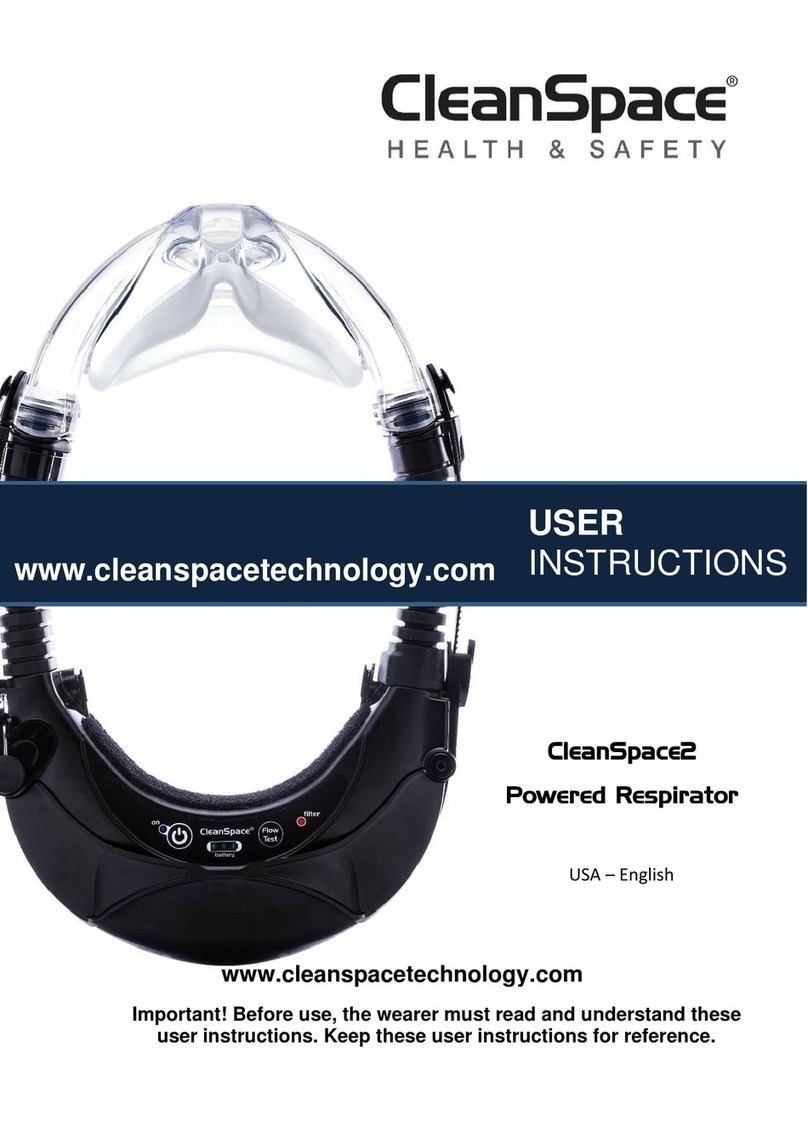
CleanSpace
CleanSpace CleanSpace2 User manual

CleanSpace
CleanSpace EX User manual
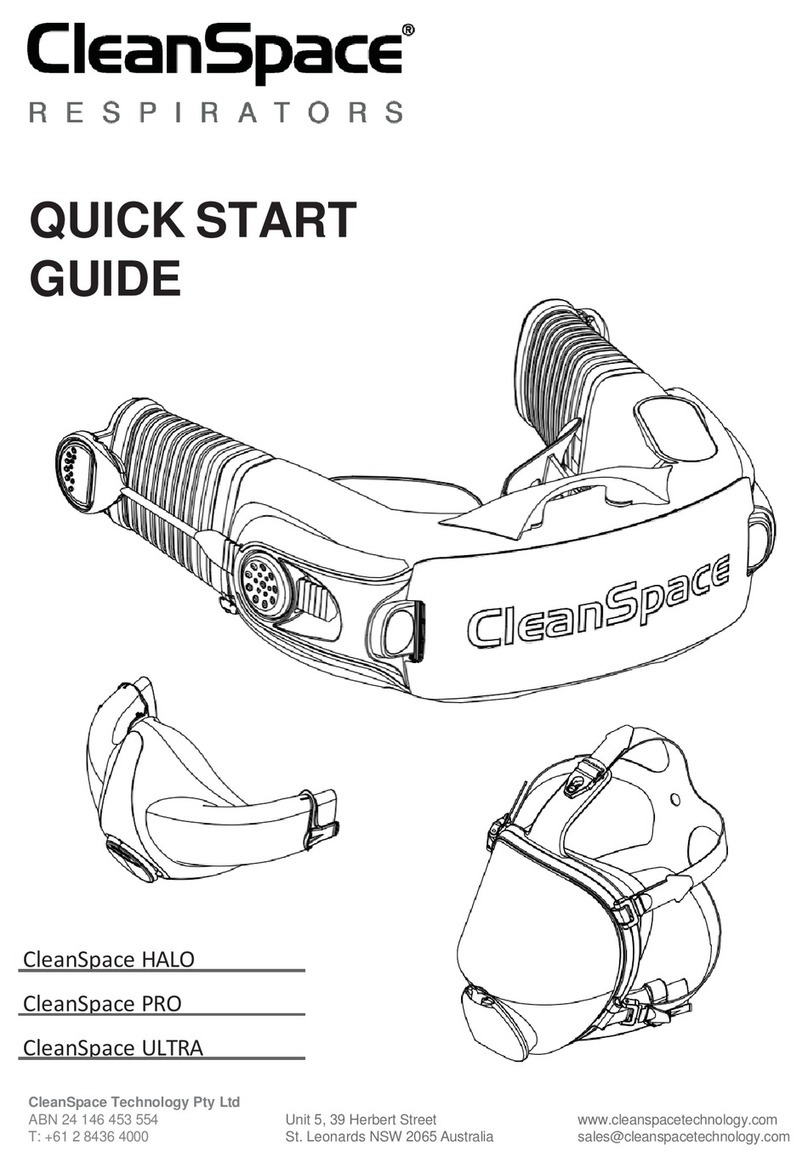
CleanSpace
CleanSpace HALO User manual

CleanSpace
CleanSpace CleanSpace2 Installation instructions
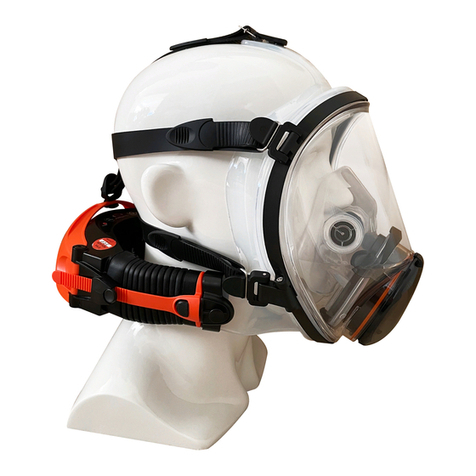
CleanSpace
CleanSpace ULTRA User manual

CleanSpace
CleanSpace HALO User manual

CleanSpace
CleanSpace CleanSpace2 User manual

CleanSpace
CleanSpace PRO User manual

CleanSpace
CleanSpace HALO CS3021 with BIO-HOOD User manual

